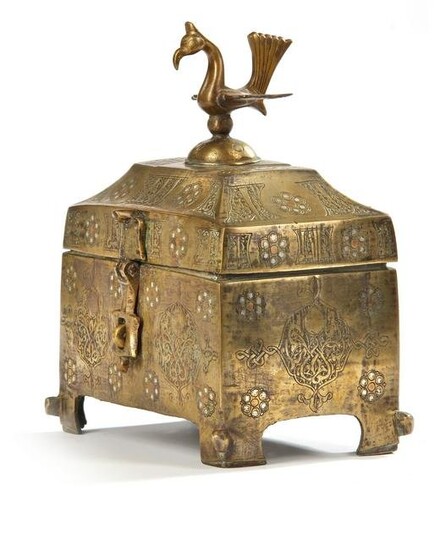AN ISLAMIC JEWELLRY BOX, 12TH-13TH CENTURY
An ornate bronze box is of a type attributed by Melikian-Chirvani to Western Iran. Formed from a large rectangle that rests on four short feet, with a body decorated in intricate silver inlay, which includes rosettes at each corner and a large floral motif either side of a lock. The large sturdy hinged lock suggests it was used specifically to store valuable items and highlights the practical function of the object that elegantly combines form and function. The top part of the box is composed of a lid with sloping shoulders and contains a large bronze exotic bird with its wings spread and tail plumage fanned as if in flight. 20 by 16 by 11 cm.CATALOGUE NOTE As was tradition for luxury metal goods in the Medieval Islamic period, a fine inlay of silver has been applied to the box, which highlights the intricate detail of the decoration, contrasting the gold and reflecting the intricacy of the design whether by sunlight or flame. It also displays the wealth and taste of the owner while simultaneously hinting at the rich contents inside – perhaps fine jewellery or precious objects that needed to be kept safe from prying hands and eyes.Islamic bronze workers in Iran during the Sasanian and post Sasanian periods often played with the proportions of different alloys. Highly tinned alloys (around 20% tin) would result in a very reflective silver finish. This casket has a more golden tone with red patina, which can most likely be attributed to higher levels of copper, zinc or lead that can be found in the alloy. The wonderful color has a rich shimmer and brilliant patina, and speaks highly of the mastery of these Islamic metalworkers. A similar bronze box can be found in the David Collection in Copenhagen, Denmark.
[ translate ]Estimate
Time, Location
Auction House
An ornate bronze box is of a type attributed by Melikian-Chirvani to Western Iran. Formed from a large rectangle that rests on four short feet, with a body decorated in intricate silver inlay, which includes rosettes at each corner and a large floral motif either side of a lock. The large sturdy hinged lock suggests it was used specifically to store valuable items and highlights the practical function of the object that elegantly combines form and function. The top part of the box is composed of a lid with sloping shoulders and contains a large bronze exotic bird with its wings spread and tail plumage fanned as if in flight. 20 by 16 by 11 cm.CATALOGUE NOTE As was tradition for luxury metal goods in the Medieval Islamic period, a fine inlay of silver has been applied to the box, which highlights the intricate detail of the decoration, contrasting the gold and reflecting the intricacy of the design whether by sunlight or flame. It also displays the wealth and taste of the owner while simultaneously hinting at the rich contents inside – perhaps fine jewellery or precious objects that needed to be kept safe from prying hands and eyes.Islamic bronze workers in Iran during the Sasanian and post Sasanian periods often played with the proportions of different alloys. Highly tinned alloys (around 20% tin) would result in a very reflective silver finish. This casket has a more golden tone with red patina, which can most likely be attributed to higher levels of copper, zinc or lead that can be found in the alloy. The wonderful color has a rich shimmer and brilliant patina, and speaks highly of the mastery of these Islamic metalworkers. A similar bronze box can be found in the David Collection in Copenhagen, Denmark.
[ translate ]


